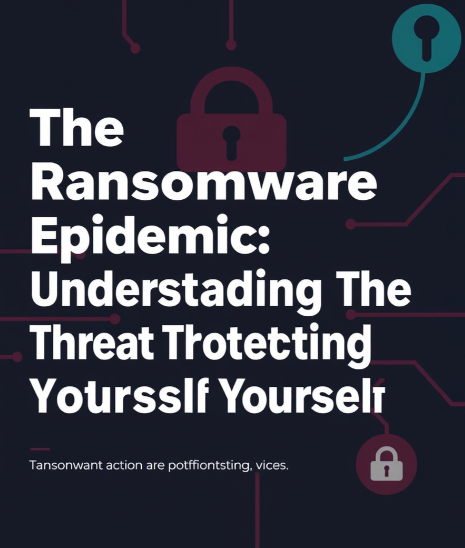The Ransomware Epidemic

In recent years, ransomware attacks have become a major concern for individuals and organizations alike. Ransomware is a type of malicious software that encrypts a victim’s files and demands a ransom in exchange for the decryption key. With the increasing reliance on technology, ransomware attacks have become more sophisticated and frequent, making it essential to understand the risks and take necessary precautions to prevent them.
What is Ransomware?
The Ransomware Epidemic: Ransomware is a type of malware that uses encryption to lock a victim’s files, making them inaccessible. The attacker then demands a ransom in exchange for the decryption key, which is needed to unlock the files. Ransomware attacks can be launched through various means, including phishing emails, infected software downloads, and exploited vulnerabilities in operating systems and software.
How Ransomware Attacks Happen
The Ransomware Epidemic: Ransomware attacks can happen in various ways, including:
- Phishing emails: Ransomware can be spread through phishing emails that trick users into downloading infected attachments or clicking on malicious links.
- Infected software downloads: Downloading software from untrusted sources can result in ransomware being installed on a device.
- Exploited vulnerabilities: Ransomware can exploit vulnerabilities in operating systems and software to gain access to a system.
- Infected external devices: Connecting an infected external device, such as a USB drive, to a computer can spread ransomware.
- Drive-by downloads: Visiting an infected website can result in ransomware being downloaded onto a device without the user’s knowledge or consent.
How Ransomware Attacks Affect Computers
The Ransomware Epidemic: Ransomware attacks can have devastating consequences for computers and the data stored on them. Some common effects of ransomware attacks include:
- Data loss: Ransomware can result in permanent data loss if the decryption key is not obtained.
- Financial loss: Paying the ransom does not guarantee that the decryption key will be provided, and it can also lead to financial loss.
- System downtime: Ransomware attacks can cause system downtime, resulting in lost productivity and revenue.
- Reputation damage: Ransomware attacks can damage an organization’s reputation, leading to loss of customer trust and loyalty.
Types of Ransomware
There are several types of ransomware, including:
- Locker ransomware: This type of ransomware locks the victim’s computer or specific files, demanding a ransom in exchange for the decryption key.
- Crypto-ransomware: This type of ransomware encrypts the victim’s files, demanding a ransom in exchange for the decryption key.
- Doxware: This type of ransomware threatens to publish the victim’s sensitive information unless a ransom is paid.
- Ransomware as a Service (RaaS): This type of ransomware allows attackers to use pre-built tools and infrastructure to launch ransomware attacks.
How to Prevent Ransomware Attacks
The Ransomware Epidemic: Preventing ransomware attacks requires a combination of awareness, education, and technical measures. Here are some tips to help you prevent ransomware attacks:
- Keep software up to date: Regularly update operating systems, browsers, and software to ensure you have the latest security patches.
- Use antivirus software: Install antivirus software to help detect and remove malware.
- Avoid suspicious emails and attachments: Be cautious when receiving unsolicited emails or attachments, and avoid clicking on links or downloading attachments from unknown sources.
- Use strong passwords: Use strong, unique passwords for all accounts, and avoid using the same password across multiple accounts.
- Use a firewall: Enable the firewall on your device to block unauthorized access.
- Use encryption: Use encryption to protect sensitive data, such as financial information and personal data.
- Back up data: Regularly back up data to prevent data loss in the event of a ransomware attack.
What to Do If You’re a Victim of a Ransomware Attack
If you’re a victim of a ransomware attack, there are several steps you can take:
- Disconnect from the internet: Immediately disconnect from the internet to prevent the ransomware from spreading.
- Contact authorities: Contact law enforcement and your organization’s IT department to report the attack.
- Do not pay the ransom: Paying the ransom does not guarantee that the decryption key will be provided, and it can also lead to financial loss.
- Restore from backups: If you have backups, restore your data from the backups.
Conclusion
The Ransomware Epidemic: Ransomware attacks are a growing threat that requires attention and action from individuals and organizations alike. By understanding how ransomware attacks work and taking steps to prevent them, we can reduce the risk of falling victim to these attacks. Remember, ransomware attacks can have devastating consequences, including data loss, financial loss, and reputation damage. By being proactive and taking necessary precautions, we can protect ourselves and our organizations from the growing threat of ransomware attacks.
Please join us on LinkedIn for latest cyber space update.



